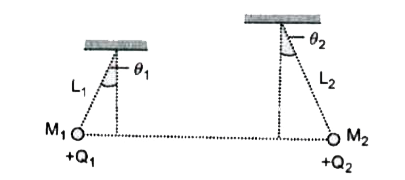An electron of mass me and a proton of mass mp are moving with the same speed.The ration of their de-Broglie's wavelengths λeλp isSolution in Kannada
1
1836
11836
918
The correct Answer is:B
de-Broglie.s wavelength,
λ=hmv
For electron,
λe=hmev
for photon
λp=hmpv
∴λeλp=h/mevh/npv
λeλlp=mpme
λeλp=1.67×10−279.1×10−31
Topper's Solved these Questions
- BOOK - MODERN PUBLICATIONCHAPTER - ELECTRONS & PHOTONSEXERCISE - MULTIPLE CHOICE QUESTIONS (LEVEL-III)9videos
ELECTRONS & PHOTONS
- BOOK - MODERN PUBLICATIONCHAPTER - ELECTROMAGNETIC WAVESEXERCISE - RECENT COMPETITIVE QUESTIONS4videos
ELECTROMAGNETIC WAVES
- BOOK - MODERN PUBLICATIONCHAPTER - ELECTROSTATICSEXERCISE - RECENT COMPETITIVE QUESTIONS39videos
ELECTROSTATICS
Similar Questions
Energy required for the electron excitation in Li++ from the first to the third Bohr orbit is :
01:59View SolutionThe speed of electromagnetic wave in vacuum depends upon the source of radiation
03:27View SolutionTwo small spheres of masses M1andM2 are suspended by weightless insulating threads of lengths L1andL2 The spheres carry charges Q1andq2 respectively . The spheres are suspended such that they are in level with one another and the threads are inclined to the vertical at angles of θ1andθ2 as shown . Which one o fthe following conditions , if θ1=θ2 ?
 03:17View Solution
03:17View SolutionA proton and an electron are accelerated by the same potential difference, let λe and λp denote the de-Broglie wavelengths of the electron and the proton respectively
04:11View Solutionlambda_(e),lambda_(p) and lambda_(alpha) are the de-Broglie wavelength of electron, proton and alpha particle. If all the accelerated by same potential, then
02:47View SolutionAccording to de-Broglie hypothesis, the wavelength associated with moving electron of mass 'm' is 'lambda_(e)' . Using mass energy relation and Planck's quantum theory, the wavelength associated with photon is 'lambda_(p)' . If the energy (E) of electron and photonm is same, then relation between lambda_e and 'lambda_(p)' is
View SolutionThe de-Broglie wavelength of an electron, an α -particle and a proton are λe,λα,λp. Which is wrong from the following:
02:59View SolutionAn electron of mass m_(e) and a proton of mass m_(p) are moving with the same speed. The ratio of their de-Broglie wavelength lamda_(e)//lamda_(p) is
02:35View SolutionThe de-Broglie wavelength of an electron, an α-particle and a proton are λe,λa,λp. Which is wrong from the following?
01:52View SolutionA proton and an electron are accelerated by same potential difference have de-Broglie wavelength lambda_(p) and lambda_(e ) .
01:12View Solutionइलेक्ट्रॉन का द्रव्यमान me तथा प्रोटॉन का द्रव्यमान mp है, इन्हें समान विभवांतर से त्वरित करने पर इलेक्ट्रॉन तथा प्रोटॉन से सम्बन्धित डी-ब्रोगली तरंगदैर्ध्य का अनुपात λe:λp होगा -
03:04View SolutionIf alpha particle, proton and electron move with the same momentum, then their respective de Broglie wavelengths lambda_(alpha), lambda_(p), lambda_(e ) are related as
01:52View SolutionAn electron of mass me and a proton of mass mp are accelerated through the same potential. Then the ratio of their de Broglie wavelengths is
01:17View SolutionAn electron of mass m_(e) and a proton of mass m_(p) are moving with the same speed.The ration of their de-Broglie's wavelengths (lambda_(e))/(lambda_(p)) is
01:47View Solutionयदि अल्फा कण, प्रोटोन और इलेक्ट्रॉन एक समान संवेग से गतिज हो, तब उनकी डी-ब्रोग्ली तरंग दैर्ध्य λα,λp,λe आपस में संबद्धित होंगे
01:32View Solution

